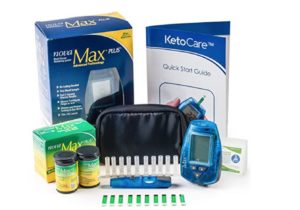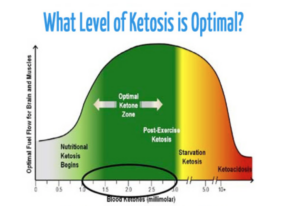Keto Diet Jump Start
Nutrition | July 04, 2015
I decided to get myself into Keto for the next few months, to get better through the heat here in L.A., improve my flexibility, and to supercharge my brain. If you want to read about all the benefits that Ketogenic diet has to offer, then check out my recent post: Ketogenic Diet Benefits.
There are a few things you should know about Ketogenic diet and what it takes to get started. The transition period that takes place before getting into the fat burning state is typically not an easy one. Keep in mind that you will be going through something called “metabolic shift” which is usually accompanied by headaches, fogginess, and other symptoms that come with switching to fat as a main source of energy. There are ways to minimize the symptoms if you follow the rules and avoid common mistakes. I’ve had a really smooth transition – it took me only 3 days to get into Ketosis. The headache lasted only for the 1st day. I was pee-ing every 10 minutes, but the 4th day I was already reaping the benefits and feeling awesome.
1. Use Ketone test strips or Ketostix (I buy them in a local pharmacy) to track whether or not you’re in Ketosis. The sticks will confirm that ketones are being excreted through your urine, and give you a validation that it’s working. I measure my levels daily, just to make sure that I’m on the right track and didn’t eat something that kicked me out of Keto. If the sticks don’t change color, then you’re not in Ketosis. The depth of the color doesn’t really matter. As long as you’re showing a trace, you’re good. If the stick gets too dark, you might be dehydrated.
This is a new update on how to properly measure your ketones. I used to use ketostix but it turns out that it’s not the most accurate way to find out if you’re within the optimal ketone zone (see the graph below). The blood meter will therefor help you a lot in optimizing your diet to stay on track without. Nutritional Ketosis ranges between 0.5 to 3.0 mM.
This is exactly the one I use as of 2018.
2. Eat 20g or less net carbs a day.
If you want to get over the transition hump as fast and smoothly as possible, then keep the carbs below 20g at least for the first couple weeks. Once your body gets used to the new energy source, you might be able to increase your carb intake by 5g a week up to 50g or more. Typically it’s never more than 100g per day for anyone.
The net carbs are your total dietary carbohydrates without the fiber content.
3. Be aware of your caloric intake – It’s true that the focus of this diet is on macronutrients, not calories, because fat and protein are quite filling, so you won’t be feeling as hungry anymore. This doesn’t mean that you can eat unlimited amount of calories and expect to lose weight or stay lean. The basic math and science still applies – if you eat more than you burn, the excess calories will be stored as fat. Common sense can be applied here. If you’re happy with the way you look and feel, don’t worry about calories. If you see yourself gaining unwanted weight, do a reality check on your caloric intake. A rule of thumb for Keto diet caloric intake is your weight in lbs multiplied by 15 if you’re a woman or 16 if you’re a man.
Example: Jenny is a woman that weighs 130 lbs. 130 x 15 = 1950 cal
Jenny should aim for about 1950 cal a day. If Jenny wants to lose weight, then she should cut down on 20% of her caloric intake which would get her down to 1600 cal a day.
4. Keto is Low Carb / Moderate Protein / High Fat
Example: If Jenny eats 1950 calories a day, then she should be eating 5-10% of her calories from net carbs, 15 – 30% calories from protein, and 65 -75 % or more from fat in order to benefit from ketosis.
It may seem complicated at first, but I really don’t count calories – I’m just generally aware of how much I approximately eat.
When it comes to macronutrients, I don’t worry about the carbs that come from certain foods like green leaf veggies, or cruciferous veggies, because those are super low by nature. Simplify the process by stuffing your face with delicious foods that are high in fat and very low in carbs often.
5. Drink plenty of water. This is very important. You will be thirsty as the body goes through the process of flushing out the excess of water. The great news is that you won’t be dealing with water retention anymore, however it takes time for your body to adjust so expect to be pee-ing every 10 minutes like a 4 year old for at least the first 3 days. It can get you dehydrated really fast so make sure to drink a lot of water!! At least 3 liters (100 ounces) of water a day.
Don’t leave your home without a bottle of water!
6. Eat enough salt. In Keto, your body doesn’t hold on to water the same way so sodium and other electrolytes get flushed out quickly. That can cause dizziness and make you feel awful, so it’s really important that you supplement with salt, and even magnesium and potassium. Salted broth is a great way to replenish the flushed out electrolytes. I always drink a chicken broth or eat something salty like macadamia nuts whenever I start feeling light-headedness.
7. Include a lot of fiber. Sometimes, Keto dieters might experience some difficulties with constipation, which can be solved by including more diatery fiber in your diet. If you’re eating green and leafy veggies, you should get enough dietary fiber from the food you’re eating, but there are several alternatives. You can add fiber supplement to help prevent constipation. I personally use BeneFiber because it easily dissolves in water, it’s fine in texture and you can add it to any food or even your morning bullet proof coffee without even noticing. Make sure to read labels carefully when choosing your fiber supplement. A lot of them contain sugar, artificial sweeteners or citric acid to make them taste better.
8. Give yourself enough time. One common mistake is not giving yourself enough time for your body to switch from glucose burner to ketone burner. It’s very individual but the process can take anywhere from a few days to a few weeks. Your body is not used to burn fat as a main source of energy so you have to be patient and give it enough time to learn. It’s no different then if you had to suddenly learn a new skill. We all can be great in Jump roping for example, but it’s going to take some time to learn the skill and we are going to experience some growing pains before we can reap the benefits. It’s possible that during the adaptation period, your body will go through “low carb flu”. Don’t freak out if it happens. Too many people panic, thinking low carb is killing them and go back to their old eating habits. The low carb flu is actually a good sign that your system is moving towards ketosis. If you’re about to give up, read through all the benefits again.
In a nut shell
For the first few days, focus on getting into Keto. Eat delicious foods that are high in satiating fat and very low in carbs. You don’t need to focus on counting calories, just stop eating when you feel full. This will vary from person to person, so if you’re noticing you’re gaining weight, do a reality check on your caloric intake. DRINK PLENTY OF WATER. Eat enough salt so that you have a smoother transition without too much headaches. Measure your ketone levels in blood with Blood Keton Meter.
Here are some delicious Keto recipes that will help you to get going:
Beef Carpaccio – don’t skimp on the cheese and olive oil
Post workout chocolate snack – do not include the chickpeas
Salmon Rolls – add some mayo
Chicken Pot Pie – do not include carrots
Chicken soup – do not include carrots
Chicken Alfredo with Cauliflower
Roasted tomatoes with Ricotta Cheese
Warning: This diet can be extreme for some, so make sure to consult a doctor before you decide to make any big changes to your diet. If you’re diabetic, you have to absolutely talk to your doctor first as Keto might be dangerous for you.

















Private Member |
santa cruz, ca
Hi Zuzka! I just noticed your update about the urinary ketone testing strips. I’ve read that they are accurate only when someone is transitioning into a ketogenic diet, but once they are ketone-adapted the ketones won’t show up in urine anymore (since they’re being used by the body). And that’s when one should use blood testing. What do you think? Did you notice the urine strips stopped working at some point? Thank you!
Private Member |
caseyville, illinois
F.P,
I noticed that and thought i was doing something wrong as i do not count anything. I then read that also and figure that must be it as i have no cravings and naturally gravitate towards a higher fat, low carb, moderate protein way of eating. Even on Zuzka’s other plan, I would have the carbs (vegetables do not do this to me) and i would just not be satisfied. I was not hungry, but would just have to find something sweet or just look for something to nibble. But this way of eating does not do that to me. I feel very “natural” on it. I do not find it difficult. I am glad you brought that up as i do not use my strips anymore now